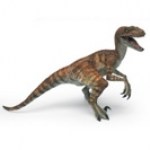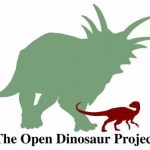paleontology
Just reported in PLoS ONE is a new dinosaur.
Spinophorosaurus nigerensis
Here are the salient facts:
Species name: Spinophorosaurus nigerensis
Who found it: Scientists with the State Museum of Natural History Braunschweig, Germany, and the Paldes Project (led by the Paleontological Museum of Elche, Spain)
Kind of dinosaur: Basal sauropod
Time period: Early and Middle Jurassic (about 200 to 170 million years ago)
What the finders say about it:
"There are very few complete skeletons of basal sauropods," Remes explains. However, complete finds are crucial for the scientists in order to…
Dinosaurs and other prehistoric creatures are one of the first things that capture kids' interest in science, but the fascination doesn't end with childhood. Paleontology takes the spotlight on ScienceBlogs this week, where bloggers are highlighting its presence in the media and current events, the arts, and education. On Laelaps, Brian Switek responds to a pro-creationist article in the Telegraph with his post on the Aetiocetus, an ancient ancestor of the whale. Not Exactly Rocket Science's Ed Yong takes us back to the 1990s when Jurassic Park's "computer-generated reptilian actors" were…
In 1916 the paleontologist H.F. Osborn published one of the strangest books on evolution I have ever read. Titled The Origin and Evolution of Life: On the theory of action, reaction and interaction of energy, the volume was an attempt to "take some of the initial steps toward an energy conception of Evolution and an energy conception of Heredity and away from the matter and form conceptions which have prevailed for over a century." Osborn hoped that by distilling the study of life to exchanges of energy the why of evolution would finally become apparent. (As I have mentioned before, Osborn…
Carl Buell's restoration of Aetiocetus weltoni. From Demere et al., 2008.
By now many of you have no doubt seen the abysmally bad story on evolution and creationism in yesterday's Telegraph. After referring to the reactions of fundamentalist Christians to the forthcoming Charles Darwin biopic Creation (based upon the book Annie's Box), the anonymous author of the piece presents the "Top 5" arguments for both evolution and creationism. The choices were baffling; it appeared that rather than do any actual research the writer extracted the selections from a bodily orifice that I will refrain…
tags: paleontology, fossils, dinosaurs, evolution, I am a Paleontologist, they might be giants, music video, streaming video
I have been remiss lately regarding music videos because I was in Finland for awhile, and then was otherwise preoccupied. But I just had to share this song with you; "I am a Paleontologist" is by the group, They Might be Giants and is one of many wonderful songs on their new album "Here Comes Science." If I was teaching biology or evolution this semester, I would use it in class.
You can order They Might be Giants' new album [CD/DVD], "Here Comes Science" from Amazon.
A Smilodon fends off vultures at what would later be called the Rancho La Brea tar pits, situated in Los Angeles, California. Painting by Charles R. Knight.
The feeding habits of saber-toothed cats have long perplexed scientists. How in the world did these cats kill prey with their almost comically-oversized teeth? Did Smilodon and its kin use their teeth like daggers to stab prey to death, or did they simply rip out a huge chunk of flesh from the side of a victim, leaving their prey to hemorrhage to death?
While the stabbing hypothesis has generally been abandoned it is still a mystery…
The skull of a brown bear (Ursus arctos), photographed at the Smithsonian's National Museum of Natural History.
The next time someone watches my apartment I will have to post a warning about the skulls. A few are in plain sight, like a badger skull on the bookshelf and a comparative set of small animal crania on the desk, but there are a few more hidden away in drawers and closets. The present disorganization of my osteological collection was very unsettling to the young woman who was taking care of the place while my wife and I were out west. She opened a drawer looking for a pen or some…
Dinosaur fossils have been dug out for a couple of centuries now. They have been cleaned up and mounted in museums and described in papers and monographs. The way this is all done has evolved over time - the early techniques were pretty crude compared to what palaeontologists do today. One of the important techniques is actually quite simple: making measurements of bones. And yes, many such bones have been measured and the measurements reported in the literature. And that literature is scattered all over the place in many different formats in many different journals. Nobody has put all the…
Zombies of the mammoth steppes. Read it now. Can you find something as riveting, yet scholarly and trustworthy, in your newspaper today?
Charles Darwin Lecture Series - Dale Russell: "Islands in the Cosmos: The Evolution of Life on Land"
DARWIN LECTURE SERIES CONTINUES!
How did we come to be here? Answers to this question have preoccupied
humans for millennia. Scientists have sought clues in the genes of
living things, in the physical environments of Earth - from mountaintops
to the depths of the ocean, in the chemistry of this world and those
nearby, in the tiniest particles of matter, and in the deepest reaches
of space. On Tuesday, September 29, Senior Curator of Paleontology Dale
Russell presents a talk based on his new book "Islands in the Cosmos:
The Evolution of Life on Land," which follows evolution from its origins…
Osborn's view of the progressive evolution of the brontotheres. Notice the references to the "geneplasm" at left, which Osborn interpreted as spontaneously giving rise to new adaptations. From Osborn (1935).
Every now and then I like taking a break from the latest technical papers and conference volumes to read some vintage scientific work. Oftentimes this is an enjoyable experience, I love the history of science, but the evolutionary work of H.F. Osborn is frustratingly opaque. While Osborn certainly was one of the most prominent figures in early 20th century paleontology he cultivated…
Scientific facts are fun. But probably to a limited number of people.
It's more fun to know how scientists got those facts - their thoughts, motivations and methods. How they did it. Why they did it. Where did they get the idea to do it in the first place.
It's even more fun, for a broader number of people, if that finding is placed in a historical context - how work of previous generations of scientists, meandering around various age-specific ideas, led to the work of this particular group.
But it is even more fun watching the historians of science at work. Most recent science is pretty easy…
Over at Dinosaur Tracking I have an interview with paleontologist extraordinaire David Hone. Among other things he talks about working in the field, science blogging, and why large predatory dinosaurs might have preferred tasty young herbivores at mealtime. This interview has been a long time coming, and I appreciate David's enthusiasm and patience during the process. Go check it out!
I have been writing a lot about extinct proboscideans lately, but when it comes to essays about elephants and their extinct relatives John McKay can't be beat. His latest is about various representations of mammoths locked in ice and is a must-read. (He even references one of the worst movies I have ever seen, Mammoth.) John promises that he has "lots more to say about this topic", too, so keep your fingers crossed for a sequel to his wonderful essay.
A restoration of the head of Pyrotherium. From W.B. Scott's A History of Land Mammals in the Western Hemisphere.
I do not remember much from my elementary school education, but there are a few fragments that have stuck with me. One day in 6th grade geography, for example, Mr. McCutcheon asked the class what we thought the continents of South America and Africa looked like. Africa was easy, it looked like the head of an African elephant (northwestern Africa being the right ear and Madagascar the tip of the trunk), but there was a greater diversity of opinion about South America. The…
Color-coded diagram of a small bone bed containing at least twelve individuals of the Permian synapsid Suminia. From Frobisch and Reisz (2009)
When I hear the phrase "early human relative" I cannot help but think of an ape-like creature. Something like Sahelanthropus fits the bill nicely; it may not be a hominin but it is still a close relative from around the time that the first hominins evolved. That is why I was a bit puzzled to see MSNBC.com parroting a story written by the Discovery Channel which proclaimed "Early human relative predates even dinosaurs"! Was this another fossil that…
When I was a kid the movie Alligator seemed to be on television almost every other weekend. It was one of the first movies I can remember seeing, although truth be told I probably should not have been allowed to watch it. The pool scene alone was enough to give me nightmares.
For those who have not seen it, the film features an enormous, marauding alligator that grew to such prodigious size by feeding on test animals a biomedical corporation dumped in the sewer. It was a pretty clever explanation for how an ordinary alligator could become so gigantic, but long before Hollywood…
A progressive "march" of elephant evolution as portrayed in Ingersoll's The Life of Animals. From left to right Moeritherium, Palaeomastodon, Gomphotherium ("Trilophodon"), Mammut americanum (American mastodon), Elephas maximus (Asian elephant).
Every now and then I like to browse through old popular-audience books about evolution. Given that I am writing such a popular book myself I enjoy looking back to see how other authors have approached the same task. In some cases I have come away quite impressed, but other times it seems that some authors of old used such platforms to give their…
A recent restoration of Deinotherium from Markov, et al (2001) "A reconstruction of the facial morphology and feeding behavior of the deinotheres." The World of Elephants, International Congress, Rome 2001. Taken from The World We Don't Live In.
Poor Deinotherium. Although it is one of the most readily recognizable proboscideans (the larger group to which modern elephants belong) it has long been treated as an uninteresting distant cousin of more popular fossil elephants like woolly mammoths. During the early 20th century, especially, it was often seen as something of a failed evolutionary…
The incomplete skull of Nicrosaurus (formerly "Belodon"), one of the earliest-recognized phytosaurs. It is missing teeth and it did not have an extended downward extension of the palate (the outline that extends below the upper jaw marked by the dotted line) like modern crocodiles. From A guide to the fossil reptiles and fishes in the Department of Geology and Palaeontology in the British Museum (Natural History).
On the occasion of our third anniversary my wife bought me one of my most favorite works of paleo-art; a scene from the late Triassic set in what is now Arizona's Petrified…

